
Alessandro di Mariano di Vanni Filipepi, known as Sandro Botticelli, was an Italian painter of the Early Renaissance. Botticelli's posthumous reputation suffered until the late 19th century, when he was rediscovered by the Pre-Raphaelites who stimulated a reappraisal of his work. Since then, his paintings have been seen to represent the linear grace of late Italian Gothic and some Early Renaissance painting, even though they date from the latter half of the Italian Renaissance period.
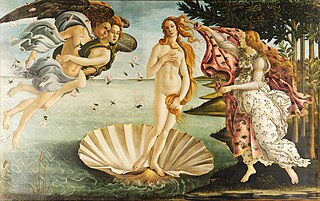
The Birth of Venus is a painting by the Italian artist Sandro Botticelli, probably executed in the mid 1480s. It depicts the goddess Venus arriving at the shore after her birth, when she had emerged from the sea fully-grown. The painting is in the Uffizi Gallery in Florence, Italy.
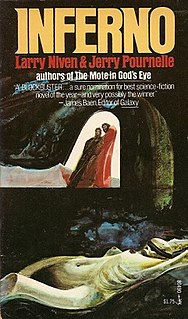
Inferno is a fantasy novel written by Larry Niven and Jerry Pournelle, published in 1976. It was nominated for the 1976 Hugo and Nebula Awards for Best Novel.
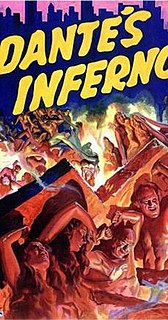
Dante's Inferno is a 1935 American drama film starring Spencer Tracy and loosely based on Dante Alighieri's Divine Comedy. The film remains primarily remembered for a 10-minute depiction of hell realised by director Harry Lachman, himself an established post-impressionist painter. This was Fox Film Corporation's last film before the company merged with Twentieth Century Pictures to form 20th Century Fox.

The Gates of Hell is a monumental bronze sculptural group work by French artist Auguste Rodin that depicts a scene from the Inferno, the first section of Dante Alighieri's Divine Comedy. It stands at 6 metres high, 4 metres wide and 1 metre deep (19.7×13.1×3.3 ft) and contains 180 figures. The figures range from 15 centimetres (6 in) high up to more than one metre (3 ft). Several of the figures were also cast as independent free-standing statues.

L'Inferno is a 1911 Italian silent film, loosely adapted from Inferno, the first canticle of Dante Alighieri's Divine Comedy. L'Inferno took over three years to make, and was the first full-length Italian feature film.

Pallas and the Centaur is a painting by the Italian Renaissance painter Sandro Botticelli, c. 1482. It is now in the Uffizi Gallery in Florence. It has been proposed as a companion piece to his Primavera, though it is a different shape. The medium used is tempera paints on canvas and its size is 207 x 148 cm. The painting has been retouched in many places, and these retouchings have faded.

The Divine Comedy has been a source of inspiration for artists, musicians, and authors since its appearance in the late 13th and early 14th centuries. Works are included here if they have been described by scholars as relating substantially in their structure or content to the Divine Comedy.

Baccio Baldini was an Italian goldsmith and engraver of the Renaissance, active in his native Florence. All that is known of Baldini's life, apart from the date of his burial in Florence, is what Vasari says of him: that Baldini was a goldsmith and pupil of Maso Finiguerra, the Florentine goldsmith who was, according to Vasari's incorrect claim, the inventor of engraving. Vasari says Baldini based all of his works on designs by Sandro Botticelli because he lacked disegno himself. Today Baldini is best remembered for his collaboration with Botticelli on the first printed Dante in 1481, where it is believed the painter supplied the drawings for Baldini to turn into engravings, but it does not seem to be the case that all his work was after Botticelli. He has long been attributed with a number of other engravings as the leading practitioner of the Florentine Fine Manner of engraving, this rather tentatively; he is often given a "workshop" or "circle" to ease uncertainty.

In Dante's Inferno, Satan is portrayed as a giant demon, frozen mid-breast in ice at the center of Hell. Satan has three faces and a pair of bat-like wings affixed under each chin. As Satan beats his wings, he creates a cold wind that continues to freeze the ice surrounding him and the other sinners in the Ninth Circle. The winds he creates are felt throughout the other circles of Hell. In his three mouths, he chews on Judas Iscariot, Marcus Junius Brutus and Gaius Cassius Longinus. Scholars consider Satan to be "a once splendid being from whom all personality has now drained away". Satan, also known as Lucifer, was formerly the Angel of Light and once tried to usurp the power of God. As punishment, God banished Satan out of Heaven to an eternity in Hell as the ultimate sinner. Dante illustrates a less powerful Satan than most standard depictions; he is slobbering, wordless, and receives the same punishments in Hell as the rest of the sinners. In the text, Dante vividly illustrates Satan's grotesque physical attributes.
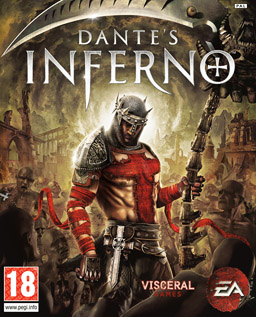
Dante's Inferno is a 2010 action-adventure game developed by Visceral Games and published by Electronic Arts. The game was released for PlayStation 3, Xbox 360, and PlayStation Portable in February 2010. The PlayStation Portable version was developed by Artificial Mind and Movement. A direct-to-DVD animated movie based on the video game, titled Dante's Inferno: An Animated Epic, was released simultaneously with it.

The Barque of Dante, also Dante and Virgil in Hell, is the first major painting by the French artist Eugène Delacroix, and is a work signalling the shift in the character of narrative painting, from Neo-Classicism towards Romanticism. The painting loosely depicts events narrated in canto eight of Dante's Inferno; a leaden, smoky mist and the blazing City of the Dead form the backdrop against which the poet Dante fearfully endures his crossing of the River Styx. As his barque ploughs through waters heaving with tormented souls, Dante is steadied by Virgil, the learned poet of Classical antiquity.

Dante's Inferno is a 1924 American silent drama film directed by Henry Otto that was released by Fox Film Corporation and adapted from Inferno, part of Dante Alighieri's epic poem Divine Comedy. The film mixes material from Dante's "Inferno" with plot points from Charles Dickens' A Christmas Carol. The book was filmed earlier in 1911 in Italy as L'Inferno, and Fox later remade the film in 1935, again as Dante's Inferno, starring Spencer Tracy in the lead role.
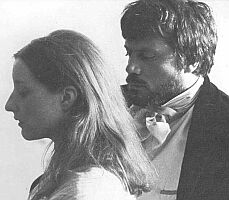
Dante's Inferno: The Private Life of Dante Gabriel Rossetti, Poet and Painter (1967) is a feature-length 35mm film directed by Ken Russell and first screened on the BBC on 22 December 1967 as part of Omnibus. It quickly became a staple in cinemas in retrospectives of Russell's work. Using nonlinear narrative technique, it tells of the relationship between the 19th-century artist and poet Dante Gabriel Rossetti and his model, Elizabeth Siddal.

Primavera, is a large panel painting in tempera paint by the Italian Renaissance painter Sandro Botticelli made in the late 1470s or early 1480s. It has been described as "one of the most written about, and most controversial paintings in the world", and also "one of the most popular paintings in Western art".

Paolo and Francesca da Rimini is a watercolour by British artist and poet Dante Gabriel Rossetti, painted in 1855 and now in Tate Britain.

Inferno is a 2013 mystery thriller novel by American author Dan Brown and the fourth book in his Robert Langdon series, following Angels & Demons, The Da Vinci Code and The Lost Symbol. The book was published on May 14, 2013, ten years after publication of The Da Vinci Code (2003), by Doubleday. It was number one on the New York Times Best Seller list for hardcover fiction and Combined Print & E-book fiction for the first eleven weeks of its release, and also remained on the list of E-book fiction for the first seventeen weeks of its release. A film adaptation was released in the United States on October 28, 2016.

Inferno is a 2016 American action mystery thriller film directed by Ron Howard and written by David Koepp, loosely based on the 2013 novel of the same name by Dan Brown. It is the sequel to The Da Vinci Code (2006) and Angels & Demons (2009), and is the third and final film in the Robert Langdon film series. It stars Tom Hanks, reprising his role as Robert Langdon, alongside Felicity Jones as Dr. Sienna Brooks, Omar Sy, Sidse Babett Knudsen, Ben Foster, and Irrfan Khan.

The Day Dream or, as it was initially intended to be named, Monna Primavera, is an oil-on-canvas painting by the Pre-Raphaelite Brotherhood founder member Dante Gabriel Rossetti. The work, which measures 158.7 centimetres (62.5 in) high by 92.7 centimetres (36.5 in) wide, was undertaken in 1880 and depicts Jane Morris in a seated position on the bough of a sycamore tree. In her hand is a small stem of honeysuckle – a token of love in the Victorian era – that may be an indication of the secret affair the artist was immersed in with her at the time. The artwork was left to the Victoria and Albert Museum by Constantine Alexander Ionides in 1900.

The Divine Comedy Illustrated by Botticelli is a manuscript of the Divine Comedy by Dante, illustrated by 92 full-page pictures by Sandro Botticelli that are considered masterpieces and amongst the best works of the Renaissance painter. The images are mostly not taken beyond silverpoint drawings, many worked over in ink, but four pages are fully coloured. The manuscript eventually disappeared and most of it was rediscovered in the late nineteenth century, having been detected in the collection of the Duke of Hamilton by Gustav Friedrich Waagen, with a few other pages being found in the Vatican Library. Botticelli had earlier produced drawings, now lost, to be turned into engravings for a printed edition, although only the first nineteen of the hundred cantos were illustrated.






















